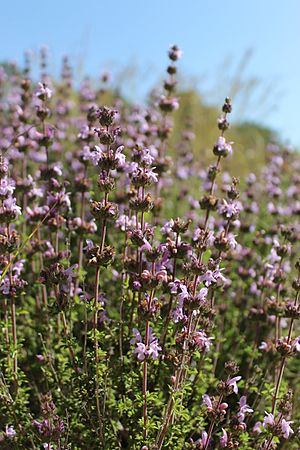Savory of Crete facts for kids
Quick facts for kids Savory of Crete |
|
|---|---|
 |
|
| Scientific classification | |
| Genus: |
Satureja
|
| Species: |
thymbra
|
| Synonyms | |
|
|
Satureja thymbra, also known as savory of Crete or pink savory, is a small, green shrub that stays green all year. It belongs to the Lamiaceae family, which includes mint and basil. This plant has very strong-smelling leaves. You can find it growing naturally in places like Libya, parts of southern Europe (from Sardinia to Turkey), Cyprus, Lebanon, and Israel.
This plant has dark-green leaves that grow close together on many branches. It usually grows to be about 20 to 50 centimeters (8 to 20 inches) tall. Its pretty pink to purple flowers bloom between March and June.
Where It Grows
This small shrub mostly grows in Mediterranean forests and scrubland. It can grow well even in higher places. You might also see it in rocky limestone areas or next to dirt roads.
In Israel, Satureja thymbra is often found in the Mount Carmel area, south of Haifa. It also grows in the mountains of Upper Galilee, in Samaria, and in the Judean mountains. It likes to grow in red clay soil called terra rossa and hard limestone. It is not often found near the coast or in the Jordan valley.
What It Looks Like
The leaves of Satureja thymbra are very fragrant. They have tiny hairs and scales that hold the plant's scent. The leaves grow opposite each other on the stem and are smooth.
Its flowers grow in rings around the stem, and their colors can be pink or purple. The fruit pods of the plant split open when they are ripe. The bark of Satureja thymbra is brownish. It has many young, straight shoots that are slightly square-shaped and covered with short, soft white hairs.
The leaves grow very close to the stem in tight groups. Each group has small, leaf-like parts called bracts, which are about 5 millimeters long and 2 millimeters wide.
Plant Power: Chemical Composition
Scientists have studied the chemicals inside Satureja thymbra. The plant contains special oils that give it its strong smell and taste. In Israel, the plant has a lot of chemicals like carvacrol, γ-terpinene, and p-cymene. Carvacrol is usually the most common one.
Other studies have found similar chemicals, but in different amounts. For example, Satureja thymbra from Lebanon has a lot of γ-terpinene, carvacrol, and thymol.
These natural oils can even help control pests! When tested against a type of tick called Hyalomma marginatum, high amounts of the plant's oil could kill the ticks. This shows it might have natural pesticide properties.
Uses of the Plant
The crushed leaves of Satureja thymbra have a very strong, sharp taste and smell. It's even stronger than some other herbs like hyssop. Because of its strong flavor, it's not commonly used as a spice today, except in places like Lebanon, where people still use it to make herbal tea.
Long ago, Satureja thymbra was used as a spice in ancient Anatolia (modern-day Turkey) and Greece. In ancient times in Palestine, people would soak Satureja thymbra in water. They then used this flavored water to season meats cooked over hot coals.
The ancient Greek doctor Dioscorides wrote about the plant's uses in his book De Materia Medica. He mentioned its medicinal benefits.
People have also used Satureja thymbra as a traditional medicine. When made into a tea, it is believed to help with tummy problems like digestion issues, diarrhea, and stomach cramps.
In Israel, Satureja thymbra is a protected plant. This means it is against the law to pick or harvest it.

